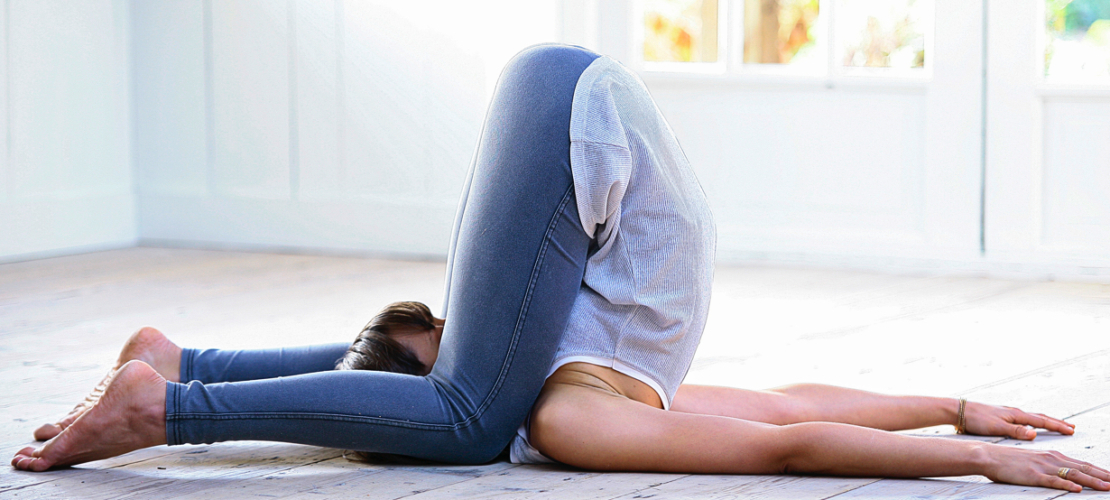Snail pose, also known as meltestasana, is an excellent posture in the yin yoga practice. In yin yoga, postures are held for longer periods of time, allowing connective tissues like fascia, ligaments, and tendons to be targeted. Snail pose is an excellent example of how yin yoga works. In this article, we’ll explore the benefits of snail pose yin yoga and how to properly practice it.
What is Snail Pose?

Snail pose is a seated forward bend that targets the connective tissues in the hips, pelvis, and lower spine. To come into the pose, you’ll start in a seated position with your legs straight out in front of you. Keep your feet flexed. As you exhale, hinge forward at the hips and reach your arms out in front of you, lowering down with control. Your torso will drape over your legs as you fold deeper into the pose. Rest your forehead on the floor, reaching your arms overhead.
Try to relax your whole body as you settle into the pose. Since yin yoga is meant to be still and passive, there should not be too much muscular engagement. Simply allow gravity to gently traction the connective tissues.
Benefits of Snail Pose

Snail pose offers many benefits when held for 3-5 minutes or longer:
- Stretches the connective tissues in the hips and pelvis. The deep fold in snail pose puts traction on the fascia and ligaments in the front of the hips and pelvis. This can help improve mobility and flexibility over time.
- Calms the nervous system. By activating the parasympathetic nervous system, snail pose can help relieve stress and anxiety. The posef quietens the mind and body.
- Prepares you for deeper hip openers. Snail pose helps gently stretch tight hip flexors and loosen up the groin area. With regular practice, it can prepare you for more challenging hip openers like pigeon pose or frog pose.
- Releases tension in the lower back. Folding forward helps decompress the lumbar spine. This can alleviate lower back tightness and discomfort.
- Improves focus and concentration. The stillness and inward awareness of snail pose improves focus and concentration skills. It also enhances mind-body connection.
How to Practice Snail Pose

Follow these tips for getting the most out of your snail pose:
- Come to your edge but don’t force the stretch. Ease into the forward bend while still maintaining length in the spine. Avoid rounding the upper back.
- Engage your core lightly to support your spine in the fold. Draw your navel in and up.
- Relax your glutes, inner thighs, and facial muscles. Soften your whole body.
- Breathe deeply into the back body to help release tension. Visualize your breath moving through the back ribs and spine.
- Hold the pose anywhere from 1-5 minutes or longer. Stay for a duration that feels challenging but not painful.
- Come out of the pose slowly, engaging your core. Avoid jerky or quick movements.
Modifications and Variations
There are a few ways to modify snail pose:
- If your hips are very tight, sit on a block or cushion to help tilt your pelvis forward. This will ease tension.
- Bend your knees and place your feet on the floor if your hamstrings are tight. Slowly straighten your legs over time.
- Rest your forehead on a block if your torso does not comfortably reach the floor. Work on flexibility before lowering all the way down.
- For a twist variation, stack your right hand on top of left, turn your torso to the left and gaze over left shoulder. Switch sides.
Conclusion
In summary, snail pose is an excellent yin yoga posture that gently stretches the connective tissues of the hips, pelvis, and lower back. It can improve flexibility, calm the nervous system, enhance focus, and prepare the body for deeper hip openers. Be sure to ease into the pose rather than forcing it, engaging your core for support. Hold the posture for 1-5 minutes, breathing deeply throughout. Snail pose is a soothing, therapeutic posture with many benefits for body and mind. Consistent practice can help you become more flexible, focused, and at ease.
FAQs About Snail Pose Yin Yoga
What is Snail Pose in Yin Yoga?
Snail Pose in Yin Yoga, also known as Salamba Sarvangasana, is a unique inversion pose. It involves lying on your back and lifting your legs over your head, allowing the feet to rest on the ground behind you. The posture resembles a snail’s curl. It gently stretches the spine and shoulders while promoting relaxation.
How is Snail Pose different from other Yin Yoga poses?
Snail Pose stands out in Yin Yoga due to its inversion nature. Unlike many Yin Yoga poses that focus on passive stretching, Snail Pose places the spine in a mild inversion, targeting different muscle groups and providing unique benefits for spinal flexibility and relaxation.
What are the physical benefits of practicing Snail Pose in Yin Yoga?
Practicing Snail Pose in Yin Yoga offers physical benefits like improved spinal flexibility and mobility. It gently decompresses the spine, stretches the shoulders, and enhances circulation. It may also help relieve tension in the neck and upper back, making it beneficial for individuals experiencing discomfort in these areas.
Can Snail Pose help with spinal flexibility and mobility?
Yes, Snail Pose can help improve spinal flexibility and mobility. The inversion and gentle stretch it provides help release tension along the spine. Regular practice can increase spinal suppleness, making it easier to maintain a healthy range of motion and overall spine health.
Are there variations or modifications for Snail Pose in Yin Yoga?
While Snail Pose is relatively simple, variations and modifications can enhance the practice. Practitioners can use props like cushions or bolsters under the shoulders for added support and comfort. These modifications make the pose more accessible and adaptable to individual needs and comfort levels.

